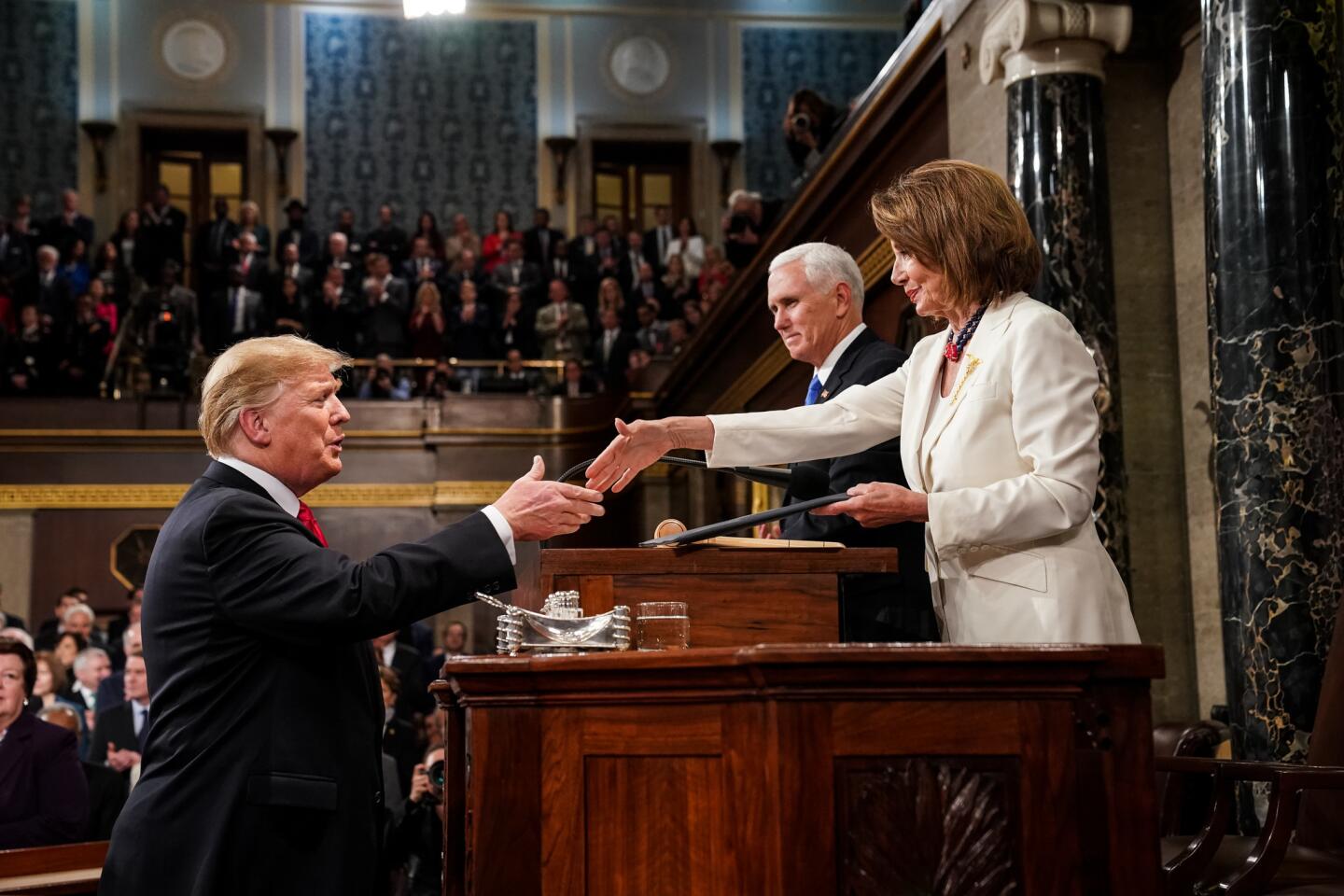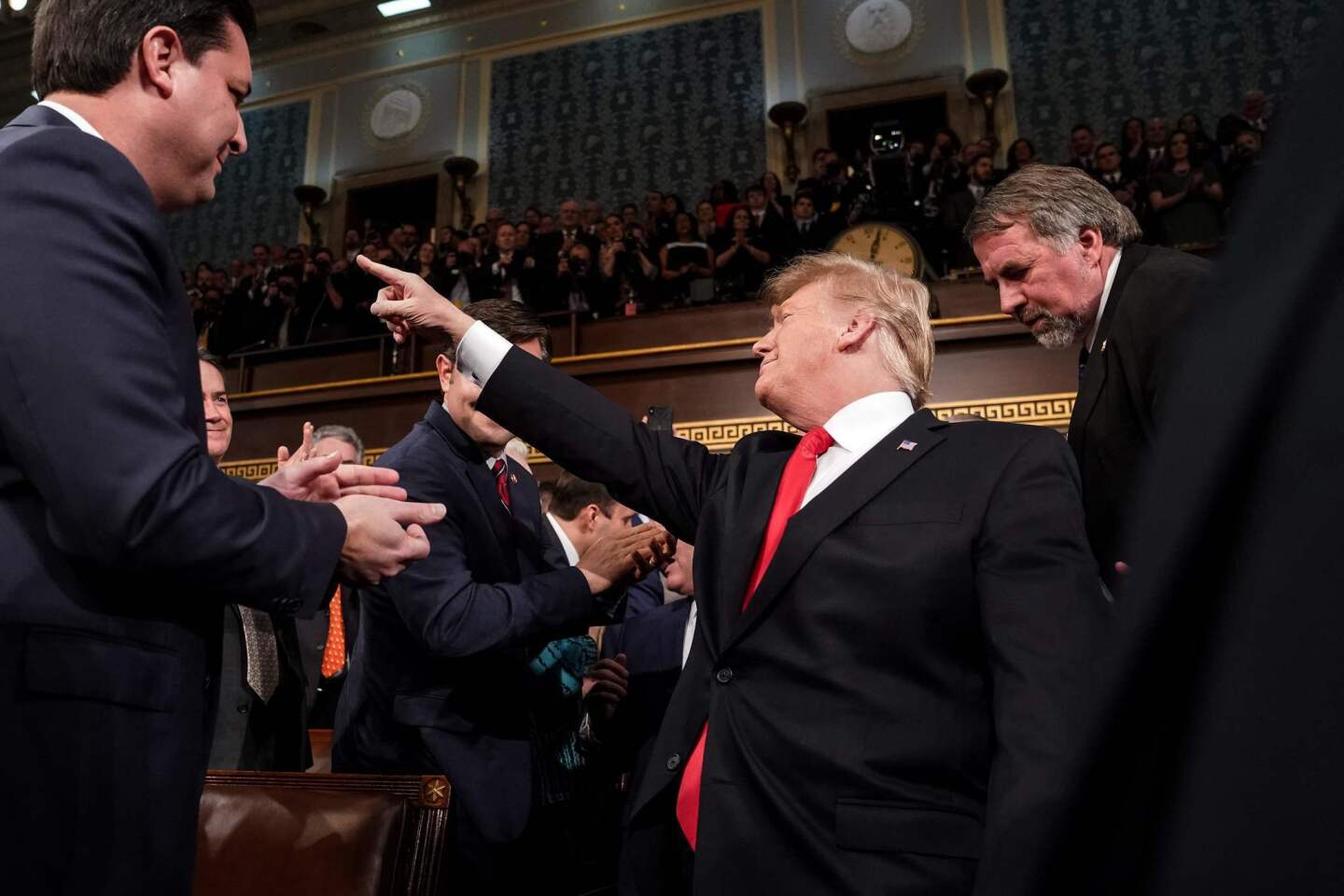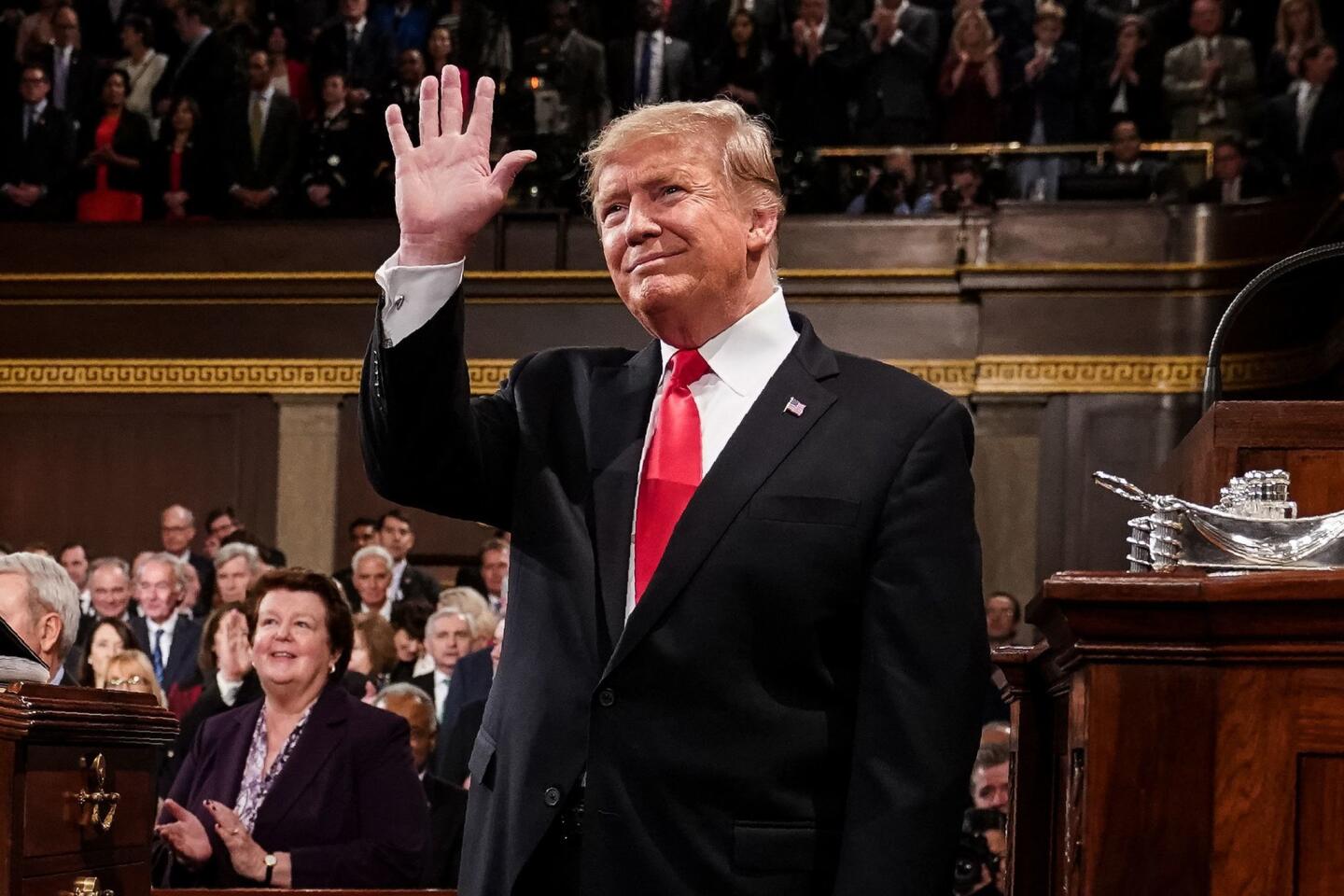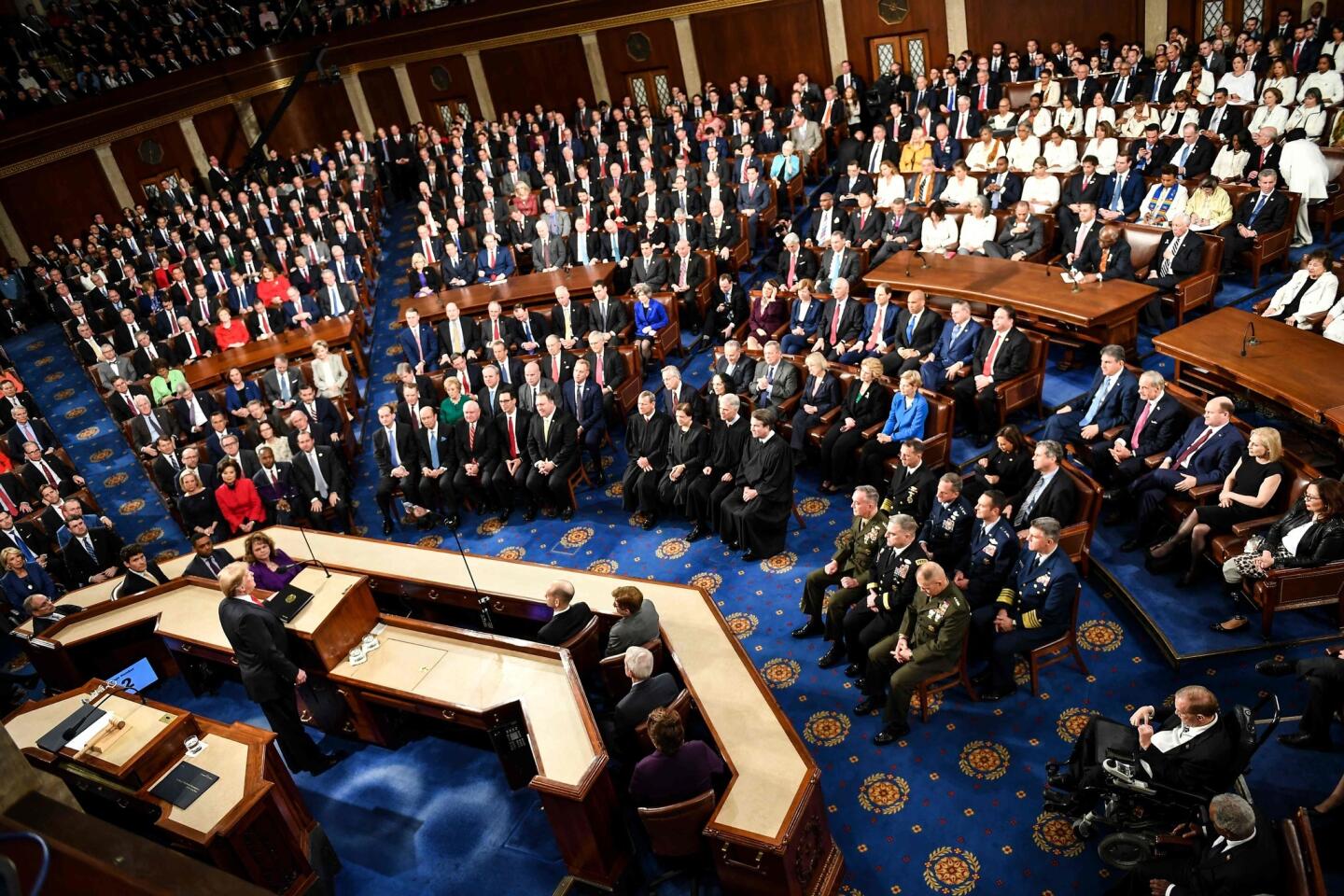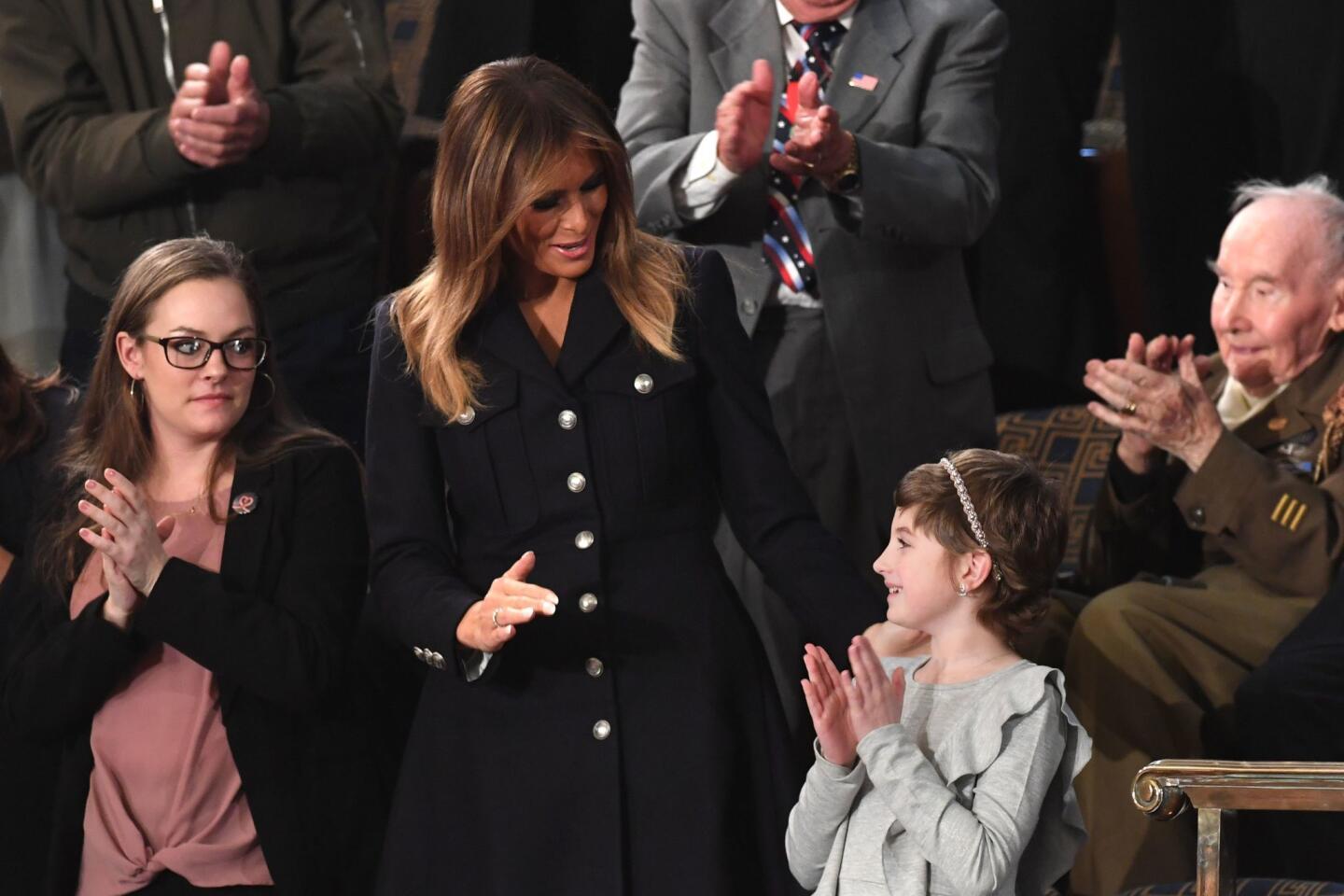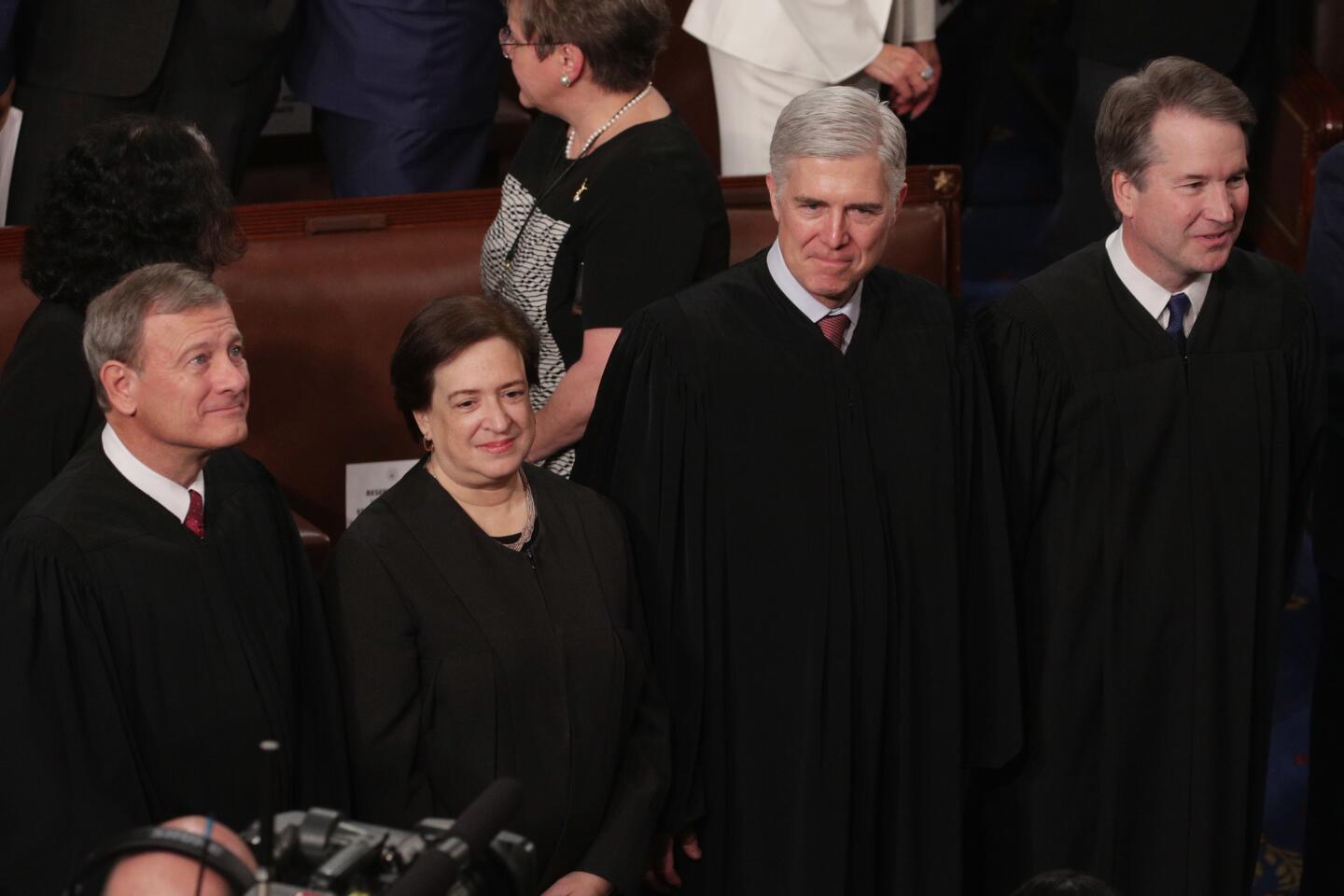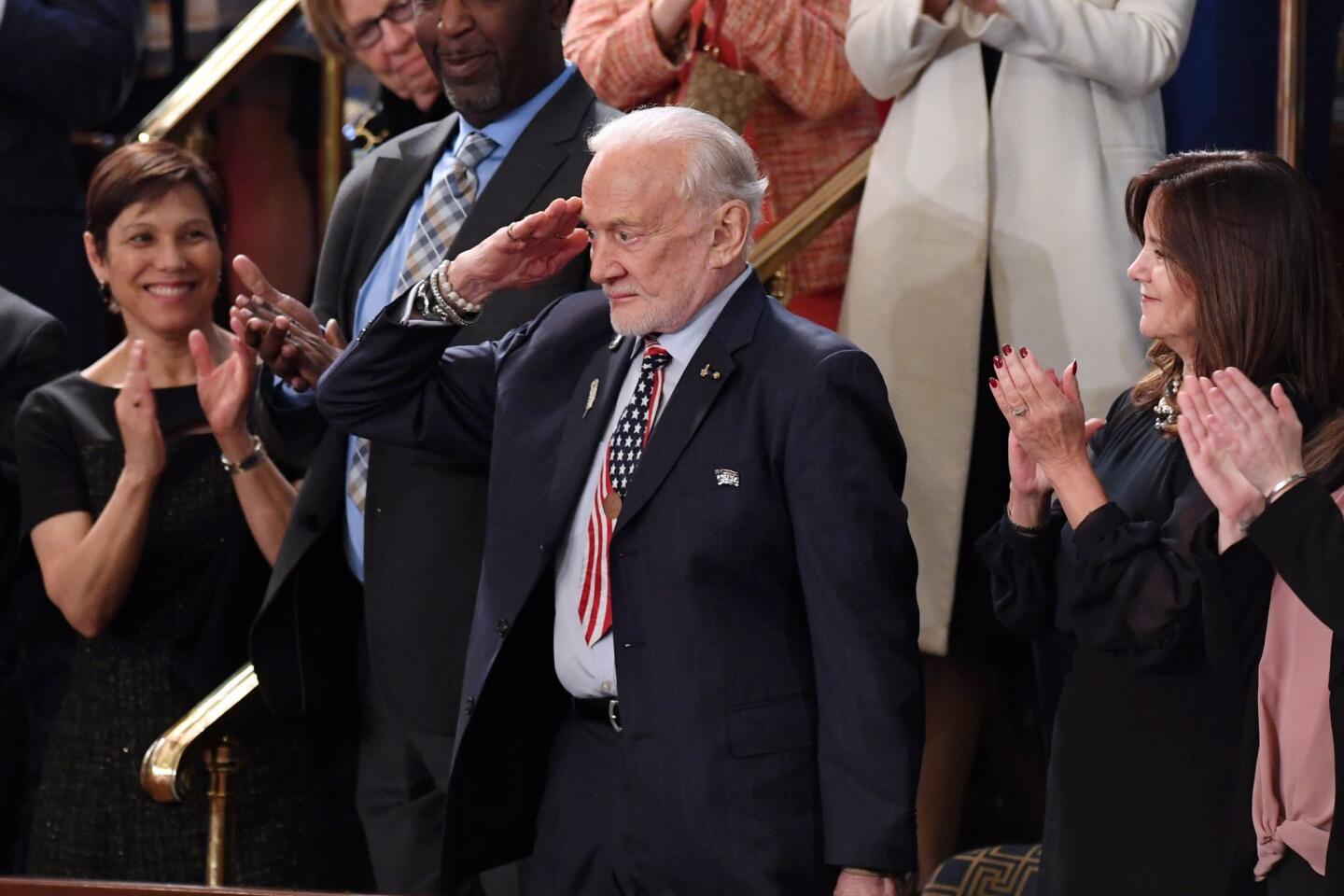Fact check: What Trump got right and wrong in his State of the Union address

Highlights from President Trump’s State of the Union address. The president’s calls for compromise were interspersed with partisan jabs.
- Share via
Reporting from Washington — The annual State of the Union address is a chance for the president to deliver his vision and policy priorities — and sometimes exaggerate or outright misstate his accomplishments and the reasons for taking policy actions.
Here’s a look at what President Trump got right and what he got wrong Tuesday night.
Economic growth
What Trump said: “In just over two years since the election, we have launched an unprecedented economic boom — a boom that has rarely been seen before. There’s been nothing like it.”
The facts: Economic growth accelerated last year as the Republican tax cuts took effect, putting the economy on track to top 3% annual growth for the first time since 2005. The partial government shutdown delayed the fourth-quarter data to confirm that.
The best year during the Obama administration was 2.9% in 2015. Experts said the U.S. economy was better in the late 1960s and 1990s.
But the initial stimulus from the tax cuts, which included slashing the corporate rate, began to fade in the second half of 2018. After expanding at a 4.2% annual rate in the second quarter last year, growth slowed to 3.4% in the third quarter and the consensus fourth-quarter forecast is about 2.6%.
The Federal Reserve is projecting 2.3% growth this year and 2% growth in 2020. Some economists are more pessimistic and said a recession could hit in 2020.
Unemployment
What Trump said: “Unemployment has reached the lowest rate in half a century. African American, Hispanic American and Asian American unemployment have all reached their lowest levels ever recorded.”
The facts: The unemployment rate dropped to 3.7% last fall, the lowest since 1969. It was the extension of a steady trend that began in 2009 after the rate surged to 10%.
The unemployment rate was up to 4% in January, but that was because more people joined the labor force.
The unemployment rates for blacks and Latinos last year hit all-time lows since the government began tracking the data in the early 1970s. That continued a downward trend that long predated Trump taking office. Both rates have climbed recently along with the broader rate and no longer are record lows.
The unemployment rate for Asian Americans was 3.2% in January. The record since that data began being kept in 2000 was 2% in May 2018.
Energy
What Trump said: “We have unleashed a revolution in American energy — the United States is now the No. 1 producer of oil and natural gas in the world. And now, for the first time in 65 years, we are a net exporter of energy.”
The facts: The U.S. is the world’s No. 1 producer of oil and natural gas. But the nation actually imports more energy than it exports — and has done so since 1953.
This could change soon but hasn’t yet. According to a recent Energy Department forecast, the country is expected to be a net exporter of coal, oil and natural gas by 2020.
NATO
What Trump said: “We have secured a $100-billion increase in defense spending from NATO allies.”
The facts: Trump is referring to the commitment by NATO members to spend at least 2% of their gross domestic product on defense by 2024. The alliance set the 2% spending target during the Obama administration.
Trump has pressed the alliance to meet that commitment, and if all 28 other countries in NATO do, total defense spending within the alliance would rise by an estimated $114 billion, according to a 2018 Brookings Institution study.
And although Trump claimed the spending increase is “secured,” not all members are expected to reach the goal by 2024.
The border wall
What Trump said: “In the past, most of the people in this room voted for a wall -- but the proper wall never got built. I’ll get it built.”
The facts: Customs and Border Protection spent about $2.3 billion between fiscal 2007 and 2015 to increase barriers on the border from 119 miles to 654 miles, according to the Government Accountability Office.
Congress has appropriated nearly $1 billion in the last two years for about 50 miles of replacement fencing in California, New Mexico and Texas. Last year, lawmakers gave Trump more than $640 million for 25 miles of new levee fencing and other “to be determined” barriers.
Trump’s impasse with Congress over his demand for $5.7 billion to build about 230 more miles of walls along the border led him to force a partial shutdown of government that lasted 35 days, the longest in U.S. history.
So far, no new miles of border barrier have been completed under Trump.
Illegal immigration
What Trump said: “I want people to come into our country — in the largest numbers ever — but they have to come in legally.”
The facts: Apprehensions at the border, the most commonly used measure for illegal immigration, are at historic lows.
The administration also has taken unusual steps to limit legal immigration.
It has targeted asylum seekers, refugees, permanent residents and green-card holders, as well as people with temporary protection from deportation who were brought to the U.S. as children or came after disasters or conflict in their home countries.
Crisis on the border
What Trump said: “Tolerance for illegal immigration is not compassionate — it is cruel. One in three women is sexually assaulted on the long journey north. Smugglers use migrant children as human pawns.”
The facts: A border security system designed for single, adult males has been overwhelmed by rising numbers of mostly Central American families and unaccompanied minors who are seeking asylum in the United States.
But academics and advocates say Trump administration policies may be putting these women, children and families at greater risk.
In December, a federal judge blocked an administration policy that sought to stop victims of gang and domestic violence from claiming asylum in the U.S.
The administration has begun forcing some asylum seekers to wait in Mexico while their cases are considered in the U.S., a dramatic shift in U.S. immigration policy. The implementation started with Tijuana -- though it suffers from high crime and violence.
Gangs and MS-13
What Trump said: “The savage gang, MS-13, now operates in at least 20 different American states, and they almost all come through our southern border.”
The facts: The Trump administration has said MS-13 poses a more serious threat to the United States than any designated transnational criminal organization — even Mexican cartels and terrorist groups.
Independent studies show the group is relatively small in the United States.
But there’s little indication that Central American families and minors fleeing gang violence have increased MS-13’s numbers north of the border. Only a fraction of unaccompanied minors apprehended since 2011 have confirmed gang ties.
North Korea
What Trump said: “If I had not been elected president of the United States, we would right now, in my opinion, be in a major war with North Korea with potentially millions of people killed.”
The facts: In 2017 and early 2018, Trump traded insults and threats with North Korean leader Kim Jong Un that sparked fears of an all-out war.
Nimble diplomacy by South Korea’s president helped arrange a way out. Trump and Kim met in June in Singapore and agreed to seek “full denuclearization of the Korean peninsula,” although U.S. officials admit that has not begun.
Islamic State
What Trump said: “Today we have liberated virtually all of that territory from the grip of these bloodthirsty killers.”
The facts: Top U.S. intelligence and military officials say Islamic State remains a potent threat even though it has lost most of the territory it once controlled.
Dan Coats, the director of national intelligence, told Congress last week that Islamic State “is intent on resurging and still commands thousands of fighters in Iraq and Syria.”
Syria
What Trump said: “It is time to give our brave warriors in Syria a warm welcome home.”
The facts: Trump said in December that all 2,000 U.S. troops were “coming back now” from Syria but the withdrawal has yet to begin. Pentagon officials now say it will take place over the next four months.
The number of U.S. troops in Syria may increase as support troops are brought in to help disassemble bases and equipment and move it out of the country.
The Pentagon wants to maintain pressure on Islamic State even after U.S. ground troops leave, and appears to be settling on a strategy that will employ airstrikes and raids by special operations troops in neighboring Iraq.
Troops to the U.S.-Mexico border
What Trump said: “I have ordered another 3,750 troops to our southern border to prepare for the tremendous onslaught.”
The facts: Trump first sent active duty troops to the border a week before the Nov. 6 midterm elections, raising concerns in the Pentagon and in Congress that he was using the military for partisan political purposes.
About 2,300 troops are now posted near border crossings, down from about 5,900 in November, to help the Border Patrol.
On Sunday, the Pentagon said it would send another 3,750 troops to help reinforce barriers and monitor crossings. That would bring the total to about 6,000, close to the original deployment.
Prescription drug prices
What Trump said: “Already, as a result of my administration’s efforts, in 2018 drug prices experienced their single largest decline in 46 years.”
The facts: Federal data show that overall per-capita spending on prescription drugs declined in 2017, though not as much spending went down in several previous years, including 2010 and 2012.
But projections suggest drug spending is once again increasing as prices continue to shoot upward. In January, pharmaceutical companies hiked prices on more than 250 prescription drugs, according to a Reuters analysis.
To read this article in Spanish, click here.
Staff writers David S. Cloud, Tracy Wilkinson, Anna Phillips and Noam Levey contributed to this report.
More to Read
Get the L.A. Times Politics newsletter
Deeply reported insights into legislation, politics and policy from Sacramento, Washington and beyond. In your inbox twice per week.
You may occasionally receive promotional content from the Los Angeles Times.
